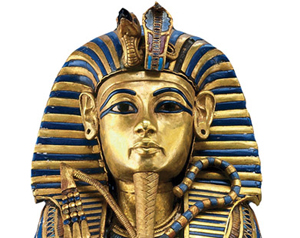Guest Post by Jacob Gucker
According to Genesis 3:15 the seed of the woman would crush the serpent’s head. This post argues for a near fulfillment of this prophecy in the birth of Israel as a nation and the crushing of Pharaoh in the Red Sea. Part one dealt with the “seed of the woman” facet of the prophecy. This part deals with “crushing the serpent’s head.”
Pictures of King Tut’s sarcophagus offer a visual clue that Pharaoh might indeed be an embodiment of the Serpent, his royal headdress clearly resembling the hood of a cobra rising up to strike. The new Pharaoh who did not knowJosephh “rose up” to strike Israel by drowning Hebrew boys in the Nile. It might have been an aggressive or violent rising with a change of regime; the language may reach back to Genesis 4 where Cain “rose up” to kill his brother.[1]
Passages in the writings of the prophets offer the strongest evidence that Pharaoh is the embodiment of the serpent of old. They call Pharaoh the dragon of the Nile (Ezekiel 29:3), the dragon of Rahab (Isaiah 51:9). The word translated “dragon” is not the same as the word for serpent in Genesis 3, nahash, but it is the same word, tannin, used in Exodus 7:9 and 12 when God instructs Moses to throw Aaron’s staff on the ground for it to become a serpent. This differs from the word used in Exodus 4 when God instructs Moses to throw his staff on the ground for the first time where it turns into a nahash. One finds that a serpent and a dragon are in the same family of animals in the Bible. The tannins might be seen as “super serpents.” They are the often serpentine chaos monsters of the Bible and the Bible refers to nations and rulers as embodiments of these beasts. Furthermore, Isaiah 27:1 places tannin and nahash in parallel with one another. Pharaoh and Egypt are thus the embodiment of the same enemy that tempted Adam and Eve, only escalated.
In Isaiah 51:9-10 the speaker urges the “Arm of the LORD” to wake up and put on strength. At one time, according to this passage, the Arm of the LORD “cut Rahab to pieces and pierced the dragon.” In the same instance He “dried up the sea,” making the depths of the sea “a way for the redeemed to pass over.” In the crossing of the Red Sea God made a way for His people to cross over, but He also drew Rahab the dragon, embodied by Pharaoh and his army, into the depths to leave him there, crushed by the flood of water.
There is yet another clue in Exodus 3 when God commands Moses to throw his staff on the ground that it might become a serpent. Humorously, Moses flees from the serpent when he sees what has become of his staff. This seemingly insignificant detail has great literary import. Moses fled from the presence of Pharaoh when his Hebrew brothers rightfully accused him of murdering an Egyptian slave-driver. Now, Moses is fleeing from the serpent. But God tells him to reach out his hand and grab it by the tail. Soon, Pharaoh will be the fleeing serpent. God hardens his heart when he hears that Israel has fled from Egypt. This incites him to give chase. God commands Israel to encamp by the Red Sea. Yahweh is laying a trap for the serpent so that the salvation of Israel and the destruction of the serpent occur in the same act of redemption and judgement. The serpent pursues, but when it becomes apparent that Yahweh is fighting for Israel, the Egyptians flee, only to be swept into the sea and destroyed.
As Israel emerges from the water alive, Miriam is there once again. She was like a midwife for her brother’s new birth from the waters of death and now she is a midwife who has helped birth the nation. She takes a tambourine in her hand and leads forth all the women of Israel who have seen Yahweh’s victory over Pharaoh. Yahweh has vindicated their courage and faith.
As Isaiah said, it was the “Arm of the LORD” who ultimately did this and readers of Isaiah 53 find that the “Arm of the LORD” is a suffering servant who “was pierced for our transgressions,” and “crushed for our iniquities. Upon him was the chastisement that brought us peace, and with His wounds we are healed.” This is Jesus and His crucifixion was a baptism in the wrath of the gentiles. As with the Exodus, the Serpent was drawn out to pursue Him into death. The Kings of the earth assembled and took counsel together, but it was a trap! God condemned Sin in His body on the tree. Jesus is Israel and the ultimate seed of the woman who would crush the Serpent’s head. All the faithful who are united to Him by baptism have gone with Him through death and are thus born again.
[1] Bodner, Keith. “Old Promise, New King.” In An Ark on the Nile: Beginning of the Book of Exodus. Oxford: Oxford University Press, 2016. Oxford Scholarship Online, 2016. doi: 10.1093/acprof:oso/9780198784074.003.0003.


















